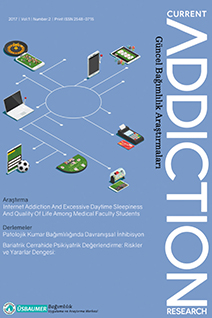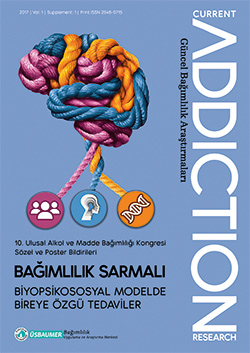Years
2020
Categories
Authors
- Altunışık Toplu Sibel (1)
- Birgul Kekliltepe (1)
- Birgül Cumurcu Hatice (1)
- Deniz Eryılmaz (1)
- Filiz Özsoy (1)
- Gul Eryılmaz (1)
- Habib Erensoy (1)
- Hasan Mervan Aytaç (1)
- Işıl Gogcegoz (2)
- Işıl GÖĞCEGÖZ (1)
- Mustafa Akan (1)
- Müberra Kulu (1)
- Sema AKKOYUN (1)
- Simge ALEVSAÇANLAR CÜCÜ (1)
- Tonguç Demir Berkol (1)
- Yasin Hasan Balcıoğlu (1)
ARTICLES
Original Article
Sema AKKOYUN,Işıl GÖĞCEGÖZ
2020, 4(2), s:47-53
Review Article
Simge ALEVSAÇANLAR CÜCÜ
2020, 4(2), s:54-62
Original Article
Habib Erensoy,Tonguç Demir Berkol,Yasin Hasan Balcıoğlu,Hasan Mervan Aytaç
2020, 4(1), s:5-15
Objective: Comorbidity of substance use disorders and other psychiatric disorders is common. However, data on the prevalence of substance use disorders in general psychiatric outpatient population is rather scarce.
Method: In order to investigate the prevalence of substance use disorders among the patients who admitted to the general psychiatric outpatient unit and followed with any psychiatric diagnosis, 734 consecutive adult patients were included in this study. Michigan Alcoholism Screening Test–AD was administered to these patients. Substance screening form and SCID-I dependence module were administered to 47 patients (6.4%) who had a MAST-AD score above 4. Later, SCID-II and the rest of SCID-I were administered to 33 patients (4.5%) who met any diagnostic criteria on this module.
Results: From these 734 patients, 33 (4.5%) had alcohol or substance use disorder: Five patients (0.7%) had alcohol dependence, 26 patients (3.5%) had alcohol abuse and 3 patients (0.4%) had multiple substance dependence. There were 9 patients (1.2%) with cannabis abuse, 4 patients (0.5%) with ecstasy abuse, 1 patient (0.1%) with heroin abuse, 1 patient with (0.1%) biperiden abuse and 9 patients (1.2%) with benzodiazepin abuse. From this 33 patients, 7 (1.0%) patients were diagnosed with borderline personality disorder, 2 (0.3%) with antisocial personality disorder, 1 patient (0.1%) with paranoid personality disorder, 1 patient (0.1%) with narcissistic personality disorder, 2 patients (0.3%) with avoidant personality disorder, 1 patient (0.1%) with schizoid personality disorder and 1 patient (0.1%) with dependent personality disorder. With SCID-I, we found 5 (0.7%) major depressive disorder, 3 (0.4%) bipolar I, 1 (0.1%) distimic disorder, 2 (0.3%) paranoid schizophrenia, 1 (0.1%) delusional disorder, 3 (0.4%) generalized anxiety disorder, 3 (0.4%) panic disorder, 1 (0.1%) panic disorder with agoraphobia, 1 (0.1%) anxiety disorder not otherwise specified, 1 (0.1%) social phobia and 1 (0.1%) post-traumatic stress disorder.
Conclusion: These results suggest that substance use disorders are not prevalent among general psychiatric outpatients. Substance use disorders should be carefully assessed in patients with diagnoses of mood disorders, anxiety disorders or personality disorders.
Original Article
Evaluation of the Factors Predicting Risky Alcohol Use in University Students
Deniz Eryılmaz,Işıl Gogcegoz,Gul Eryılmaz
2020, 4(1), s:16-20
problem in terms of mental health of the individuals and society. Substance use disorder has been evaluted as a disease by the World Health Organization (DSÖ) from 1951. In terms of alcohol consumption Turkey 4.7% of all deaths in men with prevention of alcohol consumption is predicted of 3.1% of all deaths in women could be prevented. When we analyzed the alcohol consumption in Turkey it’s thought that 4.7% of male deaths, and 3.1% of female deaths could be prevented through prevention of alcohol consumption. Risky alcohol use can be defined as the consumption of alcohol at the risk of harm in physical, mental or social areas. Participants of this study are the students at Üsküdar University in the 2018-2019 academic year. The Alcohol Use Disorders Identification Test was used to determine the alcohol use levels of the participants and to determine the risky alcohol use. According to the results of this study, the rate of individuals who have risky alcohol use is 6.3%. Risky alcohol use has become an important public health problem in terms of mental health of individuals and society.
Original Article
Assessment of University Students' Perspectives On Smokeless Campus Policy
Birgul Kekliltepe,Işıl Gogcegoz
2020, 4(1), s:21-27
The cigarette is an addictive substance being used worldwide and one of the largest risk factors for health. Due to the different substances in the cigarette, smoking can cause different diseases from skin problems to cancer. It`s the biggest cause of preventable illness and deaths in almost every country in the world. In the most developed contries many studies are done against smoking. In the last few years studies on smoking are done in our country too. One of the important examples we gave to the while world is a prohibition of smoking in public places. Tobacco free public places means that all indoor workplaces and indoor public places should be completely smokefree. Cigarette smoking is very common among college students. Many studies are made to prevent this establishing campus-wide tobacco/smoke-free environments. The main aim of this study is to evaluate the perspective of Üsküdar University students on smokeless campus policy. 414 students participated in the study. The study was based on 3 different test which were provided to all participants; Sociodemographic form, Smokeless Places Assessment Form and Fagerstrom Test for Nicotine Dependence. The analysis has shown that non smokers give more support to Smokeless Campus policy than the smokers. It was determined that the level of addiction did not cause statistically significant differences. Keywords:
Case Report
Multidisciplinary Approach to Naltrexon Implant Related Local Complications: Case Report
Mustafa Akan,Altunışık Toplu Sibel,Birgül Cumurcu Hatice
2020, 4(1), s:28-34
Case Report
Müberra Kulu,Filiz Özsoy
2020, 4(1), s:35-39
The association of alcohol /substance use disorder and attention deficit hyperactivity disorder (ADHD) is a frequently reported condition. The comorbidity of these two diseases both compromises treatment compliance and increases mortality and morbidity rates. The medical treatments used in ADHD treatment are also very limited due to their potential for abuse. In this case report, the regression of attention deficit symptoms and improvement in the neuropsychometric tests due to atomoxetine treatment in opiate use disorder patient will be presented.



 2. Sayı
2. Sayı
 1. Sayı
1. Sayı
 Ek Sayı
Ek Sayı







